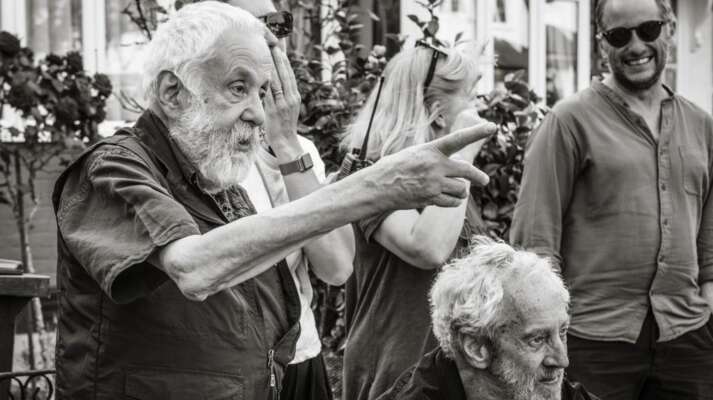Further Reading
Books dealing with the history of ANTHROPOID
Further Reading
Written by Peter Bowen
Sean Ellis’ ANTHROPOID recreates one of the most remarkable moments from World War II. In 1942, two Czechoslovakian resistance fighters changed the history of the war when they assassinated Reinhard Heydrich, the Deputy Reich Protector of Bohemia dubbed the “Butcher of Prague” for his infamous cruelty. To get to the heart of the story, Ellis focuses his drama on Jan Kubiš (Jamie Dornan)and Jozef Gabčík (Cillian Murphy), the two commandos who parachuted into the country and planned for months with the help of the Resistance before completing their mission. “I wanted to discover what it was like to be Jan Kubiš and Josef Gabčík, to know what it would have felt like to be confronted with the ultimate act of resistance,” Ellis explains. Their heroic journey is integrally connected to the larger design of history. To see the bigger picture, we’ve put together a list of books––both fiction and non-fiction––for you to continue the story after you’ve seen ANTHROPOID.

Two of the most recent and comprehensive histories of Operation Anthropoid are Callum MacDonald’s The Killing Of Reinhard Heydrich: The SS "Butcher Of Prague”and Jan Wiener’s The Assassination of Heydrich: Hitler’s Hangman and the Czech Resistance.Using “previously unpublished evidence from the files of the Foreign Office and the Special Operations Executive,” MacDonald creates a compelling examination of both Operation Anthropoid and the complex international politics that spawned it. For The New York Times’ reviewer Christopher Lehmann-Haupt, MacDonald “has provided the most complete account to date of Heydrich's assassination. He has offered a portrait of the so-called Butcher of Prague that explains why Adolf Hitler admired him so and considered him a possible successor.” As a testament to the power of MacDonald’s work, surviving members of the Czech Brigade honored him in a ceremony that took place in 1989 in his adopted hometown of Leamington Spa, just a stone’s throw away from where Kubiš and Gabčík trained for their mission in 1941. For Jan Wiener, writing The Assassination of Heydrich: Hitler’s Hangman and the Czech Resistance was in many ways a very personal affair. Wiener, a Jewish Czechoslovak who had to escape Prague right before the Nazi occupation, joined the British Royal Air Force’s No. 311 Czechoslovak Bomber Squadron to fight back. Years after the war,Wienermoved to the US where he became a professor at the American University. William L. Shirer, who wrote the celebrated The Rise and Fall of the Third Reich, penned the book’s introduction, noting that"Jan Wiener's fascinating, well-documented book tells of the heroic exploits of various Czech men and women, most of whom paid for their resistance with their lives. Above all it gives a detailed, documented account of the assassination of Reinhard Heydrich, the most gruesome of the Nazi murderers, by Czech resisters parachuted from London but aided in their task by the Czech underground." Wiener’s own remarkable life was documented in Amir Bar-Lev’s 2000 documentary Fighter.

To recognize the necessity for removing Heydrich from power, one need only review fully his terrible legacy. Robert Gerwarth’s 2012 biography Hitler’s Hangman: The Life of Heydrichprovides one of the most thorough and thoughtful biographies of the man. Following Heydrich’s life from his childhood to his rise in creating the Gestapo and helping formulate the Final Solution to his assassination, Gerwarth weaves together a complex historical and psychological picture of the man and his times. While holding Heydrich fully responsible for the enormity of his crimes against humanity, Gerwarth also tries to understand how Heydrich became that person. “Thisadmirable biography makes plausible what actually happened and makes human what we might prefer to dismiss as monstrous,”Timothy Snyder writes in The Wall Street Journal.

Other books showcase Heydrich and his legacy by recreating his world in fiction. In Philip Kerr’s Prague Fatale, the eighth in a series featuring the hard-boiled Berlin detective, Bernie Gunther, Heydrich shows up in a secondary but significant role. Set in 1941, Gunther, as a cop inside the Sicherheitspolizei (SiPo), officially works for Heydrich. After being commanded by him to come to Prague, Gunther discovers that one of Heydrich’s top men has been found shot to death in a locked room, a plot twist straight out of an Agatha Christie mystery. As Gunther gets busy looking for clues, it becomes clear the real crimes are the events happening in the background. For example, Heydrich’s castle was appropriated from the Jewish sugar baron Ferdinand Bloch-Bauer, whose wife Adele was the subject of a celebrated portrait by Gustav Klimt. The "Portrait of Adele Bloch-Bauer” was renamed “The Woman in Gold” after it too was stolen by the Nazis to be displayed without being associated with a Jewish family. In an interview with The Economist, Kerr explains, “I have always been interested in Heydrich and his assassination. What I was really interested in was the six months leading up to it. I went to Prague and let history lead me by the hand.” And history guided Kerr to detail the political terror that gripped Prague during Heydrich’s reign. “After an initially playful approach, Kerr steers his country house mystery into the darker territory of a political thriller — the kind of locked room from which there really is no way out,” points out The New York Times’ Marilyn Stasio.

Other writers have calculated the historical importance of Operation Anthropoid, not by writing about it, but by imagining what might have happened if Heydrich had lived. In his 2008 fantasy work, The Man with The Iron Heart, Harry Turtledove conjures up an alternate history in which Heydrich survives the assassination attempt on him. After recovering, Heydrich is tasked by Himmler to create a network of partisan guerrillas who will continue the fight, even if Germany loses the war. When the Allies do take over, their attempts to occupy Germany and its territories are thwarted by an endless barrage of terrorist attacks, suicide bombers, and lethal ambushes. “What’s fun and interesting about alternate history is that it lets us look at our world in a funhouse mirror we can’t get any other ways,” Turtledove observed. In this novel, Turtledove uses Heydrich to reflect on the contemporary war in Iraq as much as the earlier conflict in Prague. For Publishers Weekly, “The parallels to the current situation in Iraq are obvious but cleverly drawn, leaving readers on both sides of the war debate with much to think about.”

For his 1963 alternate history, The Man in the High Castle, Philip K. Dick went even further back to change the course of history. Set in 1962, the novel describes a world in which the Nazis have not only won the war, but have divided the world between themselves and the Japanese. In providing a historical backdrop to explain its current geopolitical predicament, The Man in the High Castle recounts how Giuseppe Zangara actually did assassinate Franklin Delano Roosevelt soon after he became president, an event that pushed the US further into financial depression and military isolationism. In Dick’s story, resistance fighters never got the chance to attack Heydrich, who survived to become one the top Nazi leaders vying to wrest control from a frail and elderly Hitler. In 2015, Dick’s brave new world was brought to the small screen as an Amazon original series.


